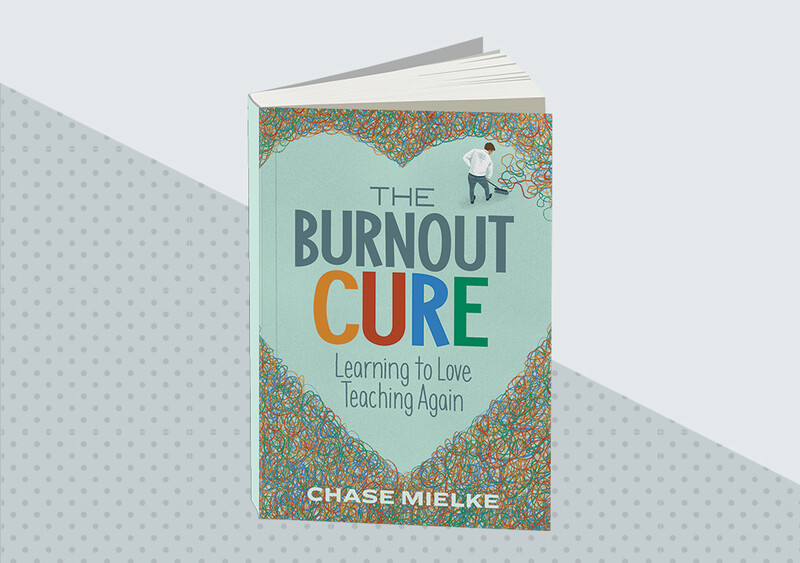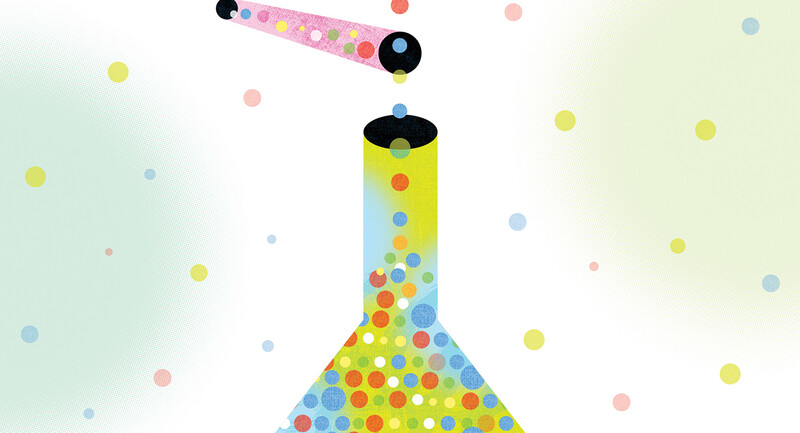High school chemistry class and I did not mix (if I had studied more, I would have come up with a better chemistry pun than that). Very few classes made my brain feel so floppy. What the junk is a mole? Iso-what? Who is making this stuff up? Where's Bill Nye when I need him!?
Yet, beneath my confusion and general teenage apathy was a respect and admiration that still lingers. Chemists make the magical rational—researching and explaining how things we can't see with the naked eye affect every aspect of life. They understand how one subatomic shift can transform whole elements. They are the ultimate demystifiers.
Though my knowledge of mole units and Mohs's scale is still woeful, I've always sought a chemist's lens when thinking about education. What are the elements of effective instruction? How are we actually measuring engagement? How does the science of learning inform our decisions? How do we demystify the molecular universe of teaching?
The last decade and a half of teaching, coaching, and PD training has shown me that there are countless elements of effective instruction. However, whether we are talking about engaging learners, embracing innovation, or battling burnout, there is one element that is fundamentally necessary for bringing education to life.
The Critical Element
Among the many elements that make up an effective educator, the most important is self-efficacy—the belief that one has the abilities and resources necessary to accomplish a set goal. Much as life wouldn't exist without carbon, imagine life without self-efficacy. Actually, you don't need to imagine it because you've seen it in action. A student lacking self-efficacy yields to learned helplessness. A department without self-efficacy falters and fights when there's a need to try something new. And a teacher without self-efficacy doesn't stay a teacher for long.
High-quality instructional bonding is the most powerful fusion you can make for increased self-efficacy.
The data on self-efficacy and its effects on teaching and learning is robust. For example, high levels of teacher self-efficacy are linked to:
Increased persistence and patience when helping struggling students learn.
Greater willingness to try new approaches.
Increased parental involvement in school.
Higher levels of student achievement across diverse demographics.
Increased job satisfaction.
Lower levels of burnout, exhaustion, and apathy. (Leithwood, 2006)
Ironically, teachers with high self-efficacy are more likely to seek out support and are more open to coaching. In other words, investing in individual self-efficacy may open the door for more collaborative collective efficacy.
Self-efficacy, however, is more than just the building block of collective efficacy. It is the critical element behind teacher well-being, innovation, engagement, and student performance. Yet it often gets lost in our school improvement plans. How many times have we ushered in a new initiative without a solid plan for supporting teachers to be efficacious in its application? How many evaluative conversations have taken place without the ongoing modeling, feedback, and coaching necessary to facilitate efficacy and growth? Sure, we might know what a teacher needs to do to improve. But do we model and support how to grow?
We have solid hypotheses, but we need to test, study, analyze, and share out the results like true scientists would. Let's start by understanding the makeup of efficacy.
The Subatomic Particles
One of the key researchers and voices on self-efficacy, Albert Bandura (1994), argued that four major sources influence our sense of self-efficacy:
Verbal Persuasion: What people say to us influences our self-efficacy. If I'm criticized, I begin to doubt my efficacy. If I'm praised, coached, or supported, my efforts are validated and my self-efficacy improves. Verbal persuasion can also be a vicarious experience (e.g., if a colleague is criticized for something I also do, I might question my own self-efficacy).
Emotional Arousal: Mood and emotion can affect our self-efficacy. For example, research has shown that when workers attend to or make an effort to recall positive emotions, self-efficacy rises (Buonomo, Fiorilli, & Benevene, 2019).
So, whether we are implementing a new literacy curriculum, revamping our multi-tiered system of supports, or trying to overcome burnout, we should build mastery experiences, social modeling, verbal persuasion, and emotional arousal into the chemistry of teachers' work. But how?
Transmutational Moves
Having put self-efficacy under the microscope, let's look at a few of the transmutational moves you can make to apply Bandura's influences and power a teacher efficacy boost.
1. Facilitate Instructional Bonding
Too often, we are stuck in the same pedagogical state because there aren't enough opportunities to observe, practice, and get feedback on different approaches. We are like molecules trying to change ourselves without outside forces or reactions. The best transmutational move any school can take is to facilitate instructional bonding through high-quality coaching and peer collaboration.
Consider that high-quality coaching provides social modeling through observing oneself or others, mastery experiences as teachers find success with new skills, and verbal persuasion through supportive dialogues with coaches and colleagues. Plus, effective coaching adds emotional arousal through affirmation and constructive feedback on what one is doing well.
One of the best places to start is to record instruction and review the video with a coach. When teachers see their teaching as it truly happened, they can focus on facts, minimizing the self-preservation that gets in the way of growth in efficacy. Conversations move from subjective evaluation to objective collaboration as a means to improve teaching.
In my district, we've implemented TeachFX, an audio-analysis app, to get more objective data for professional development discussions. Teachers use the app to record themselves and get a detailed data report and transcription of their teacher-to-student talk ratios. Our coaching team looks at these trends both individually and collectively and documents areas where we need to improve. For example, "Our high school is doing great providing opportunities for individual students to respond, but we can improve on student-to-student collaboration."
High-quality instructional bonding is the most powerful fusion you can make for increased self-efficacy.
Improving Self-Efficacy
Teachers should record their instruction and review the video with a coach. When they see their teaching as it truly happened, they can focus on facts, minimizing the self-preservation that gets in the way of growth in efficacy.
2. Create Positive Charge
Learning is hard. Teaching is hard. Facing change and challenge and energetic children is hard. The motivation and volition to take on these hard things, then, requires positive emotion. Put more simply: We don't do unpleasant things unless there is a payoff.
So, educators need to make it a mission to actively create, seek, and reflect upon positive experiences as often as possible. Whether it is keeping a gratitude journal, replacing "vent sessions" with "victory sessions," or actively and authentically praising others, we get countless opportunities each day to cultivate positive emotion. Research on well-being shows that frequency of positive emotion is more important than intensity (Fredrickson, 1998). A day of minor victories is better than a month with one major win.
One fine point on leveraging this principle for school leaders and influencers is that you want to try to tie positive emotion as tightly as possible to the teaching experience. Sure, rewards of free coffee and donuts are always welcome, but what teachers want more is affirmation that their practice is making a difference. And let's be clear: Affirmation is different than constructive feedback. If a teacher's practice needs to improve, revert to high-quality coaching. But also look for what is going well. How do we help teachers feel positive while teaching is happening, not just when teaching is over?
You don't need to schedule an observation to do it. A handwritten note, an email, a 10-second conversation in the hallway—all of these are viable ways to let teachers know what they're doing well. Just be sure you're delivering a "no strings attached" affirmation. Don't praise a teacher as a means of motivation. Praise good teaching because it's good teaching. And praise it often because good teaching is happening every day.
3. Do Frequent Elemental Analysis
Imagine being a chemist without the tools to examine and study elements—making guesses with no means to know what actually happens. Yet this is what many school leaders do when trying to understand the efficacy of staff. We guess how efficacious teachers feel. Or, more tragically, we find out too late when an educator is already burned out.
While there is plenty of research on efficacy in the field of education, we need to study efficacy frequently and longitudinally in the halls of our own buildings. Start by building efficacy surveys and reflections into the professional development you design. (For a robust analysis tool, try this “Self-Efficacy Assessment Scale” for individuals or groups.)
Link efficacy (or lack thereof) to experiences in the classroom. Adjust PD around what educators really need rather than what your best guess (or the cheapest webinar) is.
Ask your staff or team the questions in Figure 1 to get a better sense of their efficacy and needs.
Not only could school leaders use these reflection questions to improve teacher support, but individual educators could use them to take charge of their own growth. For example, after reflecting on each question, a teacher may identify a greater need of efficacy around assessment strategies. Seeking out PD around assessment while allowing other needs to stay on the back burner can help this teacher make more intentional shifts toward efficacy. A beautiful byproduct of this self-directed efficacy building is increased autonomy, which is strongly associated with improved job satisfaction and a greater intention to stay in teaching (Worth & Van den Brande, 2020).
Are you worried that your teachers might not have time to do this type of reflection? Build it into your PD. With teacher autonomy and efficacy in mind, our high school created a hybrid professional learning approach: Teachers have 15 hours of district-provided professional development and 15 hours to pursue their own development. We help them establish clear goals based on individual needs, offer resources, and build in coaching to help monitor growth. They not only track their learning but share it with their colleagues at an end-of-the-year symposium (cue: social modeling and affirmation).
The Efficacious Educator
Our schools may often seem like a chaotic chemical experiment. Hundreds of human molecular minds smashing into each other, swapping academic and emotional matter. The smallest shift (like an unwanted gas) can throw the chemistry of a room in new directions. Figuring out how to improve education can be just as rife with variables. Some schools need greater curricular alignment. Others may need more strategic and consistent systems of support. Still others need more robust technology to support modern learners.
Though our chemical equations may be different, our most important element is a motivated, skillful teacher—the efficacious educator. Whether we want to stabilize or spark change, solidify communities, or dissipate ideas, we need to invest in the chemistry of teacher self-efficacy.
Reflect & Discuss
➛ Of Albert Bandura's four major sources of self-efficacy, which one needs to be strengthened the most in your practice? Name a specific action you can take toward that end.
➛ What could you do to cultivate positive emotion in your day-to-day work, both personally and with colleagues or staff?
Teacher Well-Being
For more, read Chase Mielke's book on teacher motivation.










